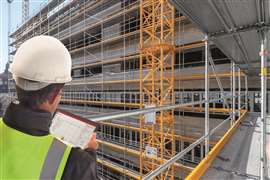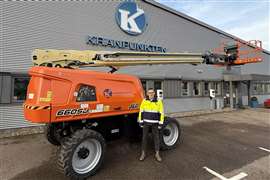Read this article in Français Deutsch Italiano Português Español
Scaffolding - fit for the future
04 March 2024
While the construction industry is suffering a noticeable setback after the boom years, scaffolders can position themselves successfully in current market dynamics, writes Philipp Merath, Director North & South America, at Peri.
There are developments and trends in the market and in scaffolding solutions that open up new opportunities for scaffolders. However, this requires the necessary flexibility and professionalism of employees and systems, which is a challenge given the current shortage of skilled labour and the rise in scaffolding prices.
The increasing complexity of construction projects and stricter safety requirements also offer opportunities to position oneself well. There are promising prospects in areas such as infrastructure, events, renovation of old buildings and energy-efficient refurbishment. Modern scaffolding systems and innovative planning solutions play a key role in leading the industry into a successful future. Increased material costs
 Flexible scaffolding systems that can be used efficiently for a wide variety of building geometries are often required
Flexible scaffolding systems that can be used efficiently for a wide variety of building geometries are often required
Rising material costs for building materials and raw materials are leading to a decline in new construction orders, which many construction companies are already feeling the effects of.
For scaffolding companies, this has the advantage that refurbishment projects in existing buildings continue to represent a stable source of income. Flexible scaffolding systems that can be used efficiently for a wide variety of building geometries are often required here. The planning of these projects can also be complicated by a lack of drawings and plans, for example, which is reflected in the increasing demand for 3D building scanning and flexible components to reduce stock levels. Another trend derived from this is the increased use of modular façade scaffolding.
Energy costs as an opportunity
Even though rising energy costs are affecting scaffolding companies, whether in terms of heating or the fuel consumption of the fleet, opportunities are arising, such as scaffolding for the installation of solar systems and the insulation of buildings and industrial plants.
In addition, planning and materials optimised for transport and storage can improve logistics and save fuel. For example, modular components can be loaded in a much more space-saving way than frames and can be flexibly adapted to different scaffolding widths. Systems that combine this space-saving component logic with quick and easy assembly are becoming increasingly popular on the market.
Personnel costs and labour
Well-trained and reliable staff rightly deserve a fair wage. Since a scaffolding company cannot hire too many of these A-level employees due to a lack of applicants or for cost reasons, it is all the more important to retain its employees and utilise them as efficiently as possible. Lightweight materials, integrated safety functions such as guardrail in advance or a self-locking anti-lift lock promote the health and safety of employees. Transport systems also make it possible to complete projects with fewer personnel in less time and with less physical effort. An example is Peri’s integrated advanced guardrail and the STS 300 Scaffold Transport System. This not only enables vertical and horizontal transport, but also the simultaneous loading and unloading of the cages, which significantly increases the assembly performance.
High financing costs
The demand for more flexibility without investment costs could be met by the scaffolding rental option. This can not only cover peaks in demand, but also minimise the variety of items in the warehouse. In addition, scaffolding hire makes it possible to realise larger or special projects without having to buy the material directly. In this way, new customer groups or areas of application can be developed with less risk. In addition to the versatility of components, the ability to combine them with other solutions is a way of preparing for new market trends. Scaffolding systems such as Peri Up are not only compatible with shoring and formwork solutions, but also with steel components from the Variokit Engineering Construction Kit.
In position
 QuickSolve façade planner helps projects to be designed more intuitively.
QuickSolve façade planner helps projects to be designed more intuitively.
Despite rising construction costs and challenges, scaffolding is positioning itself by focussing on flexibility, professionalism and innovative solutions.
Manufacturers of scaffolding systems should increasingly stand alongside scaffolders as partners rather than simply being a supplier of materials. The aim is to fully utilise the advantages of modern systems. In this way, exciting new projects can be won and profitability increased without further burdening the fitters.
In addition, the use of digital tools, such as scaffolding planners, enables planning reliability. Advancing digitalisation, including augmented and virtual reality as well as AI-based assistants, are constantly finding new areas of application.
The aim is to pave the way for an end-to-end solution from planning to invoicing and to accompany scaffolding construction into an exciting future – in which digital solutions, customised services, and partnership-based collaboration offer security in a constantly changing world.
2023_QuickSolve_construction: QuickSolve façade planner helps projects to be designed more intuitively.
Chem_FE6C4703: Flexible scaffolding systems that can be used efficiently for a wide variety of building geometries are often required
DE_ZchEssn: Safety is at forefront in modern scaffolding project design.
STAY CONNECTED



Receive the information you need when you need it through our world-leading magazines, newsletters and daily briefings.
CONNECT WITH THE TEAM












